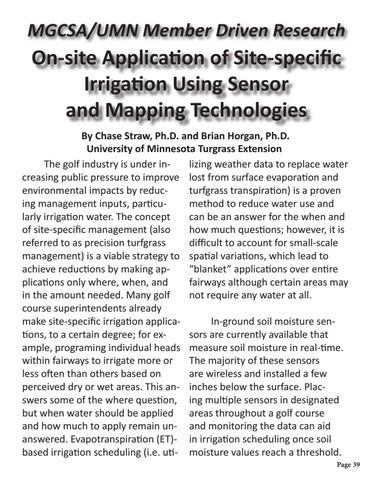MGCSA/UMN Member Driven Research
On-site Application of Site-specific Irrigation Using Sensor and Mapping Technologies By Chase Straw, Ph.D. and Brian Horgan, Ph.D. University of Minnesota Turgrass Extension The golf industry is under inlizing weather data to replace water creasing public pressure to improve lost from surface evaporation and environmental impacts by reducturfgrass transpiration) is a proven ing management inputs, particumethod to reduce water use and larly irrigation water. The concept can be an answer for the when and of site-specific management (also how much questions; however, it is referred to as precision turfgrass difficult to account for small-scale management) is a viable strategy to spatial variations, which lead to achieve reductions by making ap“blanket� applications over entire plications only where, when, and fairways although certain areas may in the amount needed. Many golf not require any water at all. course superintendents already make site-specific irrigation applica- In-ground soil moisture sentions, to a certain degree; for exsors are currently available that ample, programing individual heads measure soil moisture in real-time. within fairways to irrigate more or The majority of these sensors less often than others based on are wireless and installed a few perceived dry or wet areas. This an- inches below the surface. Placswers some of the where question, ing multiple sensors in designated but when water should be applied areas throughout a golf course and how much to apply remain un- and monitoring the data can aid answered. Evapotranspiration (ET)- in irrigation scheduling once soil based irrigation scheduling (i.e. uti- moisture values reach a threshold. Page 39
